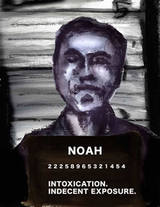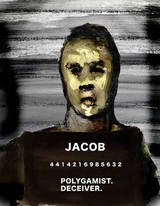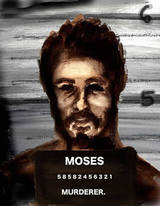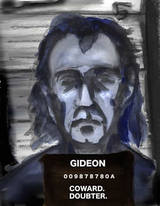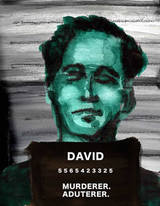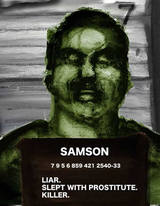In response to sticky, sycophantic treatments of the theme "Heroes of the Faith," an artist I know created these images for use in a worship service. Feel free to use them, but credit him: (C) 2005 Scott Beahm.
Continue reading...About
Welcome! This website is intended for thoughtful but harried worship planners. We invite you to explore the resources available here for planning and leading worship.
Since this is a collaborative effort, we also invite you to contribute. All are welcome to comment freely; if you are interested in becoming a posting member of this community, please click here.
If you don't want to post regularly, but do have a question, or want us the community to address a particular issue, feel free to email.
Contributers
Easter Alleluia
May 09, 2006
 In a class I'm teaching on Crafting Language for Worship, we recently had a discussion about the value of significant words and repeated phrases in worship. Some of my students from evangelical and free-church traditions reported with delight the value they have discovered in the the persistent Easter season call-and-response "Christ is risen! Alleluia!/He is risen indeed, Alleluia!" They report that using this refrain now is profoundly formative, reminding them of the catholicity of the church, and connecting them with the faithful of so many times and places.
In a class I'm teaching on Crafting Language for Worship, we recently had a discussion about the value of significant words and repeated phrases in worship. Some of my students from evangelical and free-church traditions reported with delight the value they have discovered in the the persistent Easter season call-and-response "Christ is risen! Alleluia!/He is risen indeed, Alleluia!" They report that using this refrain now is profoundly formative, reminding them of the catholicity of the church, and connecting them with the faithful of so many times and places.
All of this reminded me of a time when my congregation practiced a fast from the use of the word "Alleluia" throughout the season of Lent in anticipation of its exuberant reintroduction to worship on Easter Sunday. Throughout the forty days, we still sang songs with "alleluia" in the lyrics, but self-consciously hummed "mm-mm-MM-mm" instead.
Meanwhile, the young children of the church spent one of their education hours creating colorful construction paper butterflies, decorated abundantly with the word "Alleluia." These were then crafted into a beautiful mobile, which debuted on Easter morning hanging high over the communion table, pointing to new life in Christ. Alleluia! He is risen!
Continue reading...Living Wet
August 14, 2006
Ron’s story about baptizing his nephew and the connections of baptism to our care for creation show how multifaceted the layers of this sacrament are. All of life, for those of us born of water and the Spirit, is wet. In other words, every moment of each day is grounded in baptism. Even if we are not following the will of God, those moments are redeemed in God’s grace, which is one aspect of baptism (cleansing from or forgiveness of sin). This is why confession or at least a reflection on how we “missed the mark” or sinned is a part of the compline prayer. The ancient “compline” prayer, or prayer at the close of the day shapes our sleeping and rising in the death and resurrection of Christ. This image is one of baptismal life; continually dying (repenting and turning from ways that separate us from Christ) and rising to new life each day.
Throughout the worship service there are several moments each Sunday where we can engage water in ways that help us understand and live more deeply into our baptism. Here are a few examples:
During the gathering of the people you can pour water into the font or baptismal pool with words that accentuate our inclusion into the family of God such as:
You are a chosen race, a royal priesthood, a holy nation, God’s own people, in order that you m ay proclaim the mighty acts of the One who called you out of darkness into God’s marvelous light. (1 Peter 2:9)Continue reading...
7 Worship Leading Principles from Bono
August 16, 2006
 Dr. Steven Taylor is the founding pastor of Graceway Baptist Church in Ellerslie, New Zealand. He has a PhD on the Emerging Church and a Masters in Theology in communicating the cross in a postmodern world. Steve recently did a course at Fuller Seminary entitled “Communicating the Biblical Text in a PostModern Culture” in July.
Dr. Steven Taylor is the founding pastor of Graceway Baptist Church in Ellerslie, New Zealand. He has a PhD on the Emerging Church and a Masters in Theology in communicating the cross in a postmodern world. Steve recently did a course at Fuller Seminary entitled “Communicating the Biblical Text in a PostModern Culture” in July.
He argues that to communicate the biblical text for today’s context requires one to “incarnate, indwell, our culture.” Taylor goes on to use the phrase “DJing” with respect to the community. A record DJ learns the historical stories (old records) and uses them authentically in contemporary culture and integrates them into the community's stories. There is too much to summarize here, but do look for his book “The Out of Bounds Church: Learning to Create a Community of Faith in a Culture of Change” from Zondervan.
Taylor cites Bono of U2 as a person who effectively DJs today. According to Taylor, Bono is in fact a worship leader for over 40,000 people; Bono recontextualizes the biblical text and leads concert goers into a time of community worship and prayer. Taylor plays the “Vertigo ‘05” DVD and shows us how Bono is leading worship. This intrigued me to the point that Dr. Taylor and I discussed this further after the workshop. The following is from Steve’s article “7 Things I learnt from Bono about Worship Leading.”
1. Connect uniquely. In the Vertigo DVD, Bono speaks about Chicago and his memories of Chicago. He makes a unique connection with context, day, and time.
2. Engage through familiarity. Bono includes songs that resonate with previous experiences and previous encounters.
3. Use repetition to call forth prayer. Bono uses the repetitive “Hallelujah.” It is easy to sing. The simple repetition enables the audience to sing with the band.
4. Secure a 5th (visual) band member. U2 now has a 5th member of the band to add a visual layer to the experience. A wise worship leader will look to add not just singers or musicians, but a “visual” person to their team.
5. Create hope by drawing the best from the past. Bono tells the audience in the Vertigo DVD, “We as a band are looking to the future. We’re taking the best of the past and moving forward with hope.”
6. Plan participation. Bono can draw one boy from the audience to sing to, one woman from the audience to dance with. He uses repetition to call forth prayer and encourage congregational singing.
7. Invoke passionate practices. Bono invites the audience to hall out their cell phones and to text “Make Poverty History campaign.” A worship leader turns singing into action. He turns entertainment into justice.Continue reading...
Advent Wreath
October 24, 2006
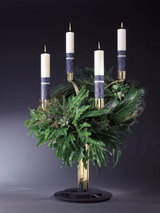 The season of Advent is the beginning of the church year. If you follow the lectionary readings for this season you will find that they are accounts of prophets proclaiming the coming of God’s kingdom and anticipation of the coming of the messiah. We re-live this anticipation through these texts, our music, and even the way creation enters more deeply into darkness until the passing of the winter solstice.
The season of Advent is the beginning of the church year. If you follow the lectionary readings for this season you will find that they are accounts of prophets proclaiming the coming of God’s kingdom and anticipation of the coming of the messiah. We re-live this anticipation through these texts, our music, and even the way creation enters more deeply into darkness until the passing of the winter solstice.
***
History and Symbolism
The Advent wreath has its roots in northern European pre-Christian practices where people sought the return of the sun in the darkest time of the year (at the winter solstice) by lighting candles and fires. By the middle ages, Christians used fire and light to represent Christ's coming into the world. Using this same symbolism, the Advent wreath developed a few centuries ago in Germany. The advent wreath signifies waiting and hopeful expectation, looking forward to both Christ’s birth and to Christ’s coming again at the end of time. The circular shape of the wreath represents eternal life. The evergreens signify the faithfulness of God and the lighted candles reminder us of the light of Christ in the world.Continue reading...
